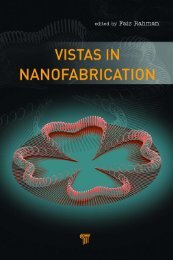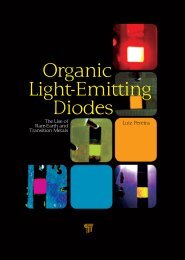Download PDF - Pan Stanford Publishing
Download PDF - Pan Stanford Publishing
Download PDF - Pan Stanford Publishing
You also want an ePaper? Increase the reach of your titles
YUMPU automatically turns print PDFs into web optimized ePapers that Google loves.
18 Introduction to SolarPowerfortheWorld<br />
(Gen3 cells) and <strong>Pan</strong>asonic (HIT cell) for several years. But<br />
the technology to produce them is more sophisticated and hence<br />
somewhat more expensive than that of standard silicon cells that<br />
are manufactured by most other companies. The same is true for the<br />
“Pluto” cell of an efficiency of just over 20% that Suntech has in pilot<br />
production; it is more complex to make.<br />
Solar cells made from polycrystalline silicon come typically<br />
on the market at somewhat lower efficiencies of approximately<br />
17% but with a slight cost advantage.<br />
CdTe solar cells on modules—thin-film cells are produced<br />
directly in integrated modules and not like silicon in individual<br />
cells—with a record efficiency of 18.7% and 14.4% in their best<br />
production line come from First Solar.<br />
The CIGS (CuInGaSe 2 ) thin-film cells come in production at<br />
best in efficiencies of approximately 13%. Over 400 MW of them<br />
were produced in 2012. The manufacturers claim that such cells<br />
are slightly more expensive to make in the co-evaporation process<br />
instead of sputtering and subsequent selenisation. On laboratory<br />
scale, efficiencies of slightly over 20% have been reached; this shows<br />
the high potential of further progress through research.<br />
For ground-mounted solar arrays, tracking the Sun is an option.<br />
It is particularly considered in the United States, which has large<br />
areas with frequently clear sky. An example is one-axis tracking<br />
with an over 30% better energy yield compared with a fixed-plate<br />
array. NREL finds that the yearly capacity factor of 17% for a fixedplate<br />
array that corresponds to a yearly harvest of 1500 kWh per<br />
kW installed, and tracking might improve that harvest by one third,<br />
achieving 2000 kWh in a year. In most parts of Europe, the Sun’s<br />
radiation energy is mainly received as diffuse radiation; tracking,<br />
which is more expensive to implement than the fixed plate, has not<br />
received the same attention.<br />
Financing and Support Mechanisms<br />
The two main support schemes for PV system investments are (1)<br />
the Feed In Tariff (FIT), which financially supports the kWh fed into<br />
the local grid, and (2) the financial support against the up-front cost
















